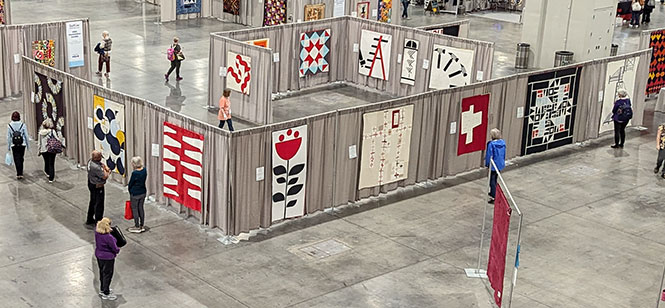Today I want to share quilts from the featured exhibit at QuiltCon 2024, entitled: belonging—the quilts of Jacquie Gering.
Reflecting on Jacquie’s impact on my own quilting journey fills me with nostalgia and gratitude. I started quilting a few years after Jacquie did herself. Shortly there after, I remember attending QuiltCon for the first time back in 2015. At that time, she was the President of the Board of the Modern Quilt Guild as well as the lively emcee of the awards presentation that year. I recall the technical AV glitches delaying the ceremony, but Jacquie’s spirited improvisation, including leading us in an impromptu “matchstick quilting” hand dance, kept the atmosphere electric.
It wasn’t until 2017, during a volunteering shift at QuiltCon, that I had the opportunity for a one-on-one chat with Jacquie. Despite her busy schedule, she generously shared her wisdom and advice as we hung quilts together. Like Jacquie, I’m in love with walking foot quilting, cherishing the simplicity and impact it brings to our quilts.
Although my time to explore her special exhibit was limited due to other commitments, I savored the quiet Sunday morning before the show floor opened, immersing myself in Jacquie’s work and the stories behind each piece.
Many thanks to my friend Abigail McMurray for sharing the above photo of the overhead view of Jacquie’s exhibit.
Enjoy this selection of Jacquie’s modern quilts from the show
Below you will find just 10 of the quilts in the exhibit. I encourage you to check out Jacquie’s website to learn more about her and see more of her work.
Quilt Exhibit Overview
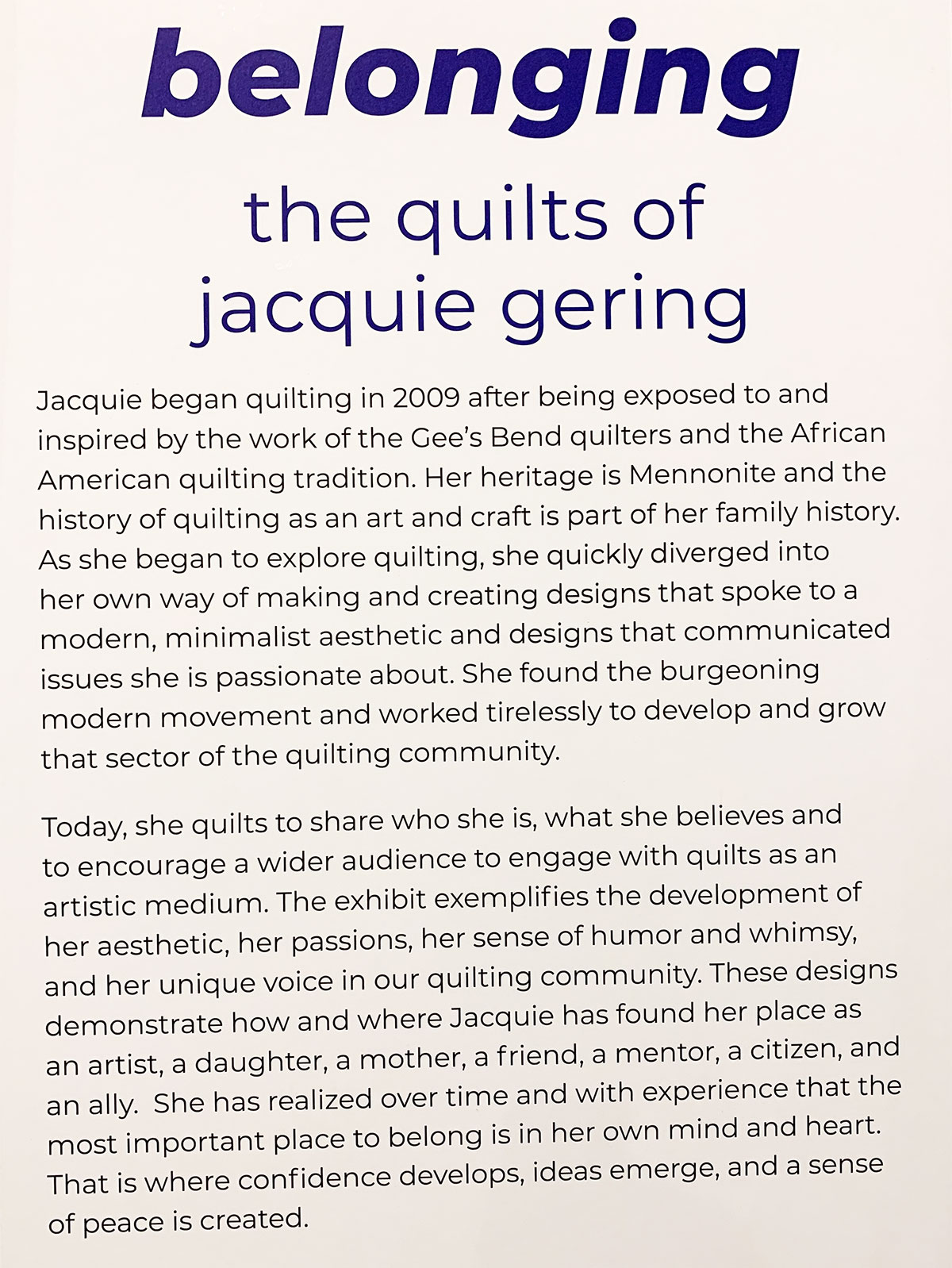
Below is a transcription of the entry panel (shown above) that was at the front of this special modern quilt exhibit:
belonging
the quilts of jacquie gering
Jacquie began quilting in 2009 after being exposed to and inspired by the work of the Gee’s Bend quilters and the African American quilting tradition. Her heritage is Mennonite and the history of quilting as an art and craft is part of her family history. As she began to expore quilting, she quickly diverged into her own way of making and creating designs that spoke to a modern, minimalist aesthetic and designs that comunicated issues she is passionate about. She found the burgeoning modern movement and worked tirelessly to develop and grow that sector of the quilting community.
Today, she quilts to share who she is, what she believes and to encourage a wider audience to engage with quilts as a artistic medium. The exhibit exemplifies the development of her aesthetic, her passions, her sense of humor and whimsy, and her unique voice in our quilting community. These designs demonstrate how and where Jacquie has found her place as an artist, a daughter, a mother, a friend, a mentor, a citizen, and an ally. She has realized over time and with experience that the most important place to belong is in her own mind and heart. That is where confidence develops, ideas emarge, and a sense of peace is created.
All quilts below were on display at QuiltCon 2024 and are by Jacquie Gering.
you don’t belong here quilt

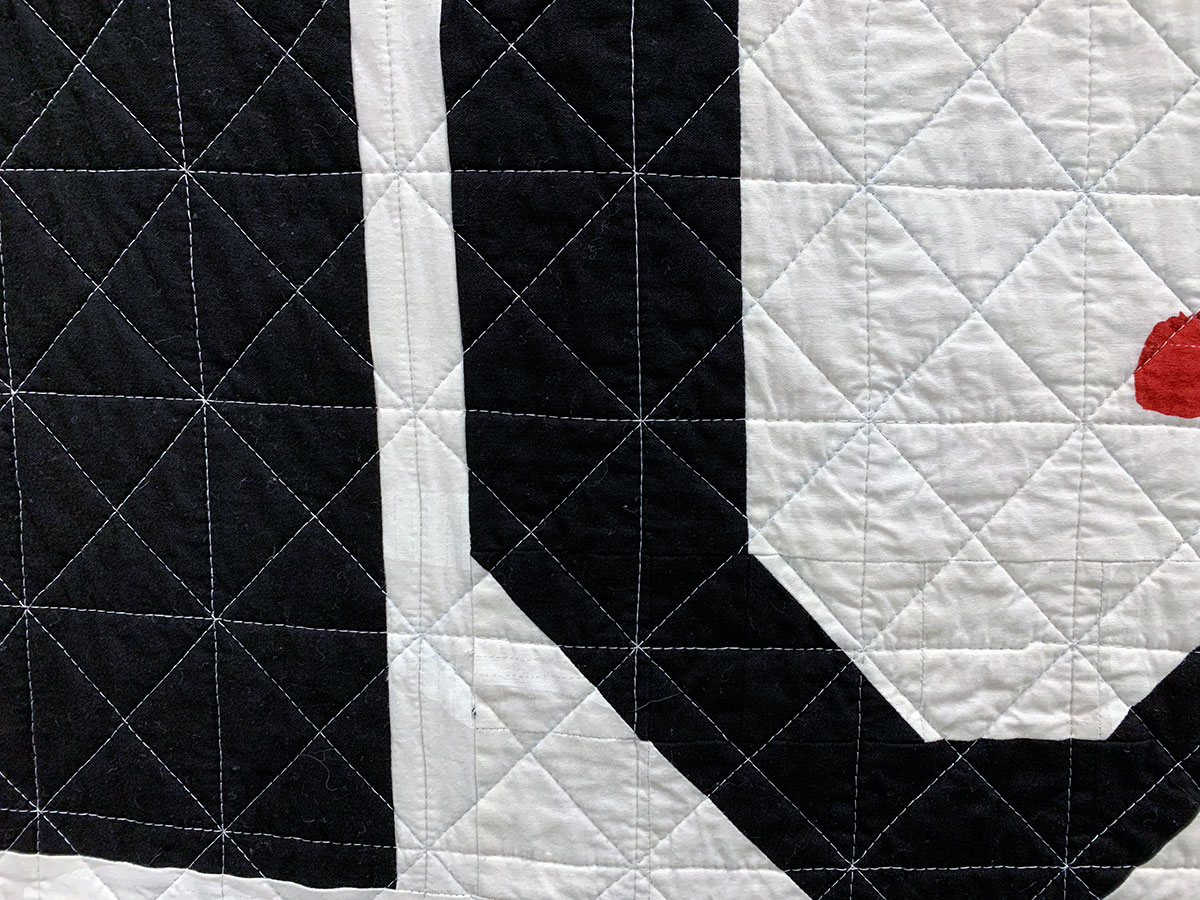
you don’t belong here
2023
74″ x 86″
Artist Statement: But I do, and so do you. Many people feel they don’t belong or are made to feel that they don’t belong. Each of us probably has a story we can share about not belinging. This piece is inspired by a story by friend, Cynthia told me years ago about how she felt in one of our work team meetings. The words come from Virgil Abloh, the creator of the fashion house, ‘Off White’. In his book he expressed how he perceived his place in the fashion industry, “you don’t belong here.” For many of our friends, neighbors, and colleagues not belonging or feeling like “the other” is an everyday experience. There are people in our world who are blatantly discriminatory, but most of us aren’t. Making people feel unwelcome can be subtle and may be part of our everyday being. We are all guilty of microaggressions, “those subtle, often, but not always, unintentional acts of discrimination that can take a toll on someone’s sense of belonging. They are like stealthy ninjas, sneaking into our daily interactions and leaving behind a trail of discomfort and unease. These covert acts can manifest in various ways, such as seemingly innocent comments, backhanded compliments, dismissive words, or gestures, or even assumptions based on stereotypes. They are the ‘paper cuts of discrimination,’ but they add up to create psychological and emotional distress.” (Credit: Kailash Ganesh) ‘you don’t belong here’ is a reminder that each of us has a role to make the world a welcoming place. We need to be self-aware and to recognize that we don’t know what we don’t know, and we will make mistakes. We can start by identifying our act, acknowledging the discomfort we caused, take responsibility for our action, and use that experience as an opportunity to do better.
Techniques: traditional piecing, walking foot quilting
f1 quilt
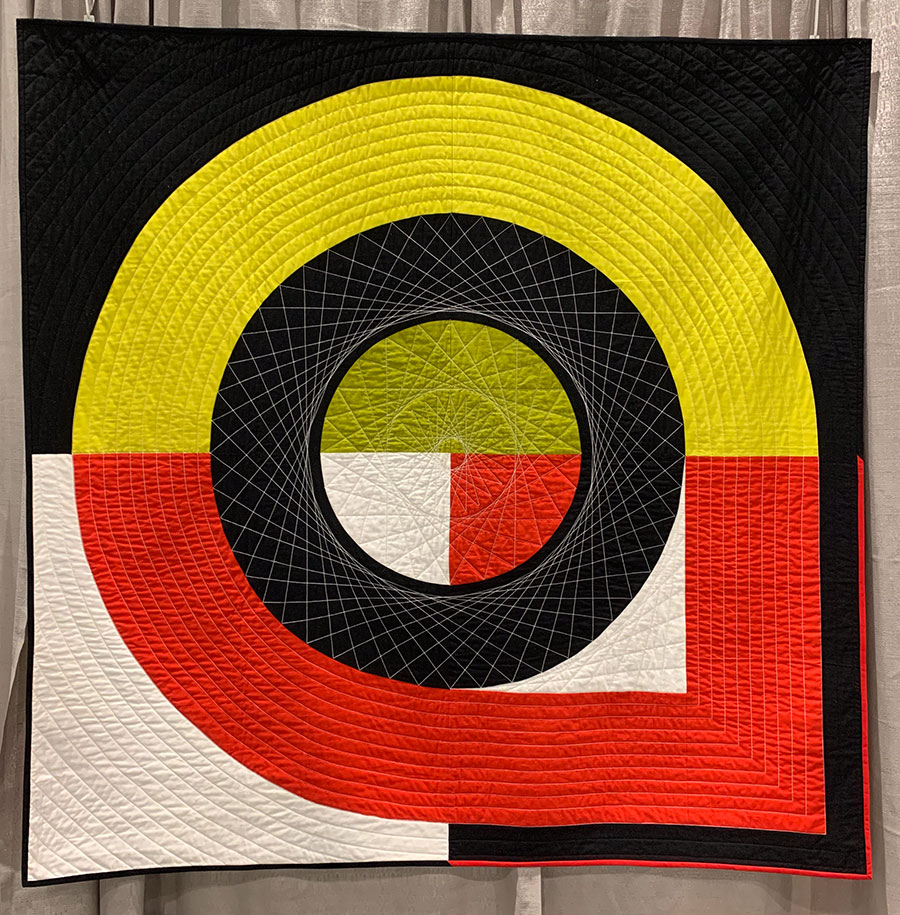
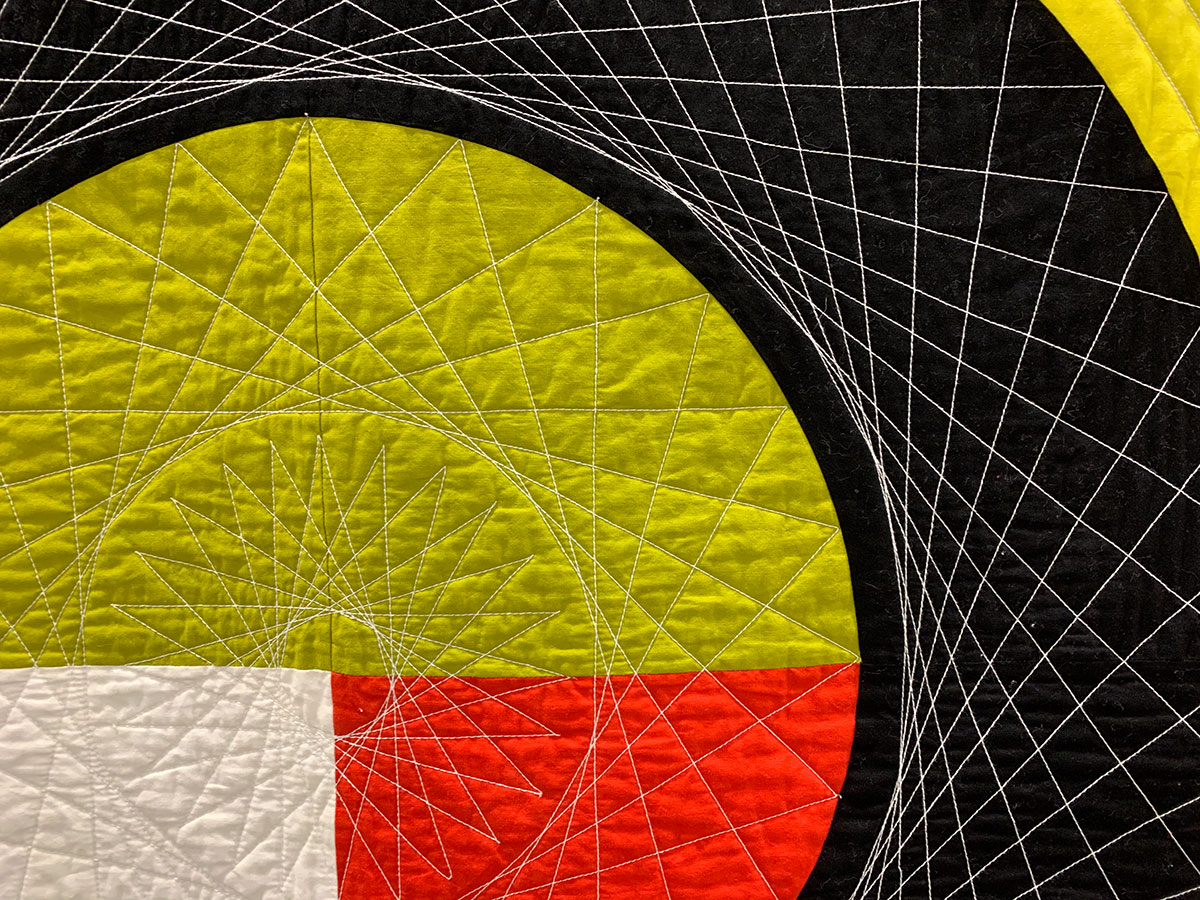
f1
2021
61″ x 61″
Artist Statement: While the ‘perfect circle’ doesn’t exist in nature, circles are rooted in the natural world. Humans have used the circle as a foundation for basic structures like the wheel as well as complex constructions. The Greek scholar Proclus called the circle “the first, simplest and most perfect form.” I find the simplicity of the circle with its underlying and hidden complexity beautiful and intriguing. My inspiration was the tires on Formula 1 race cars and the tracks on which they compete. ‘f1’ explores the circle through division, alignment, and manipulations of the basic shape. The machine quilting capitalizes on the properties of the circle in combination with lines to create dimensionality, parabolic curves, apparent circles, and star polygons which add visual texture within the simplicity of the circles and background shapes. As I explored lines used to create apparent curves and circles, I discovered the work of the English mathematician Mary Everest Boole (1832-1916) who is generally credited with creating the craft of curve stitching which she used to teach students geometric principles. Curve stitching designs and concepts have opened a new world of machine quilting designs and possibilities in my work.
Techniques: curved piecing, walking foot quilting
bang you’re dead quilt
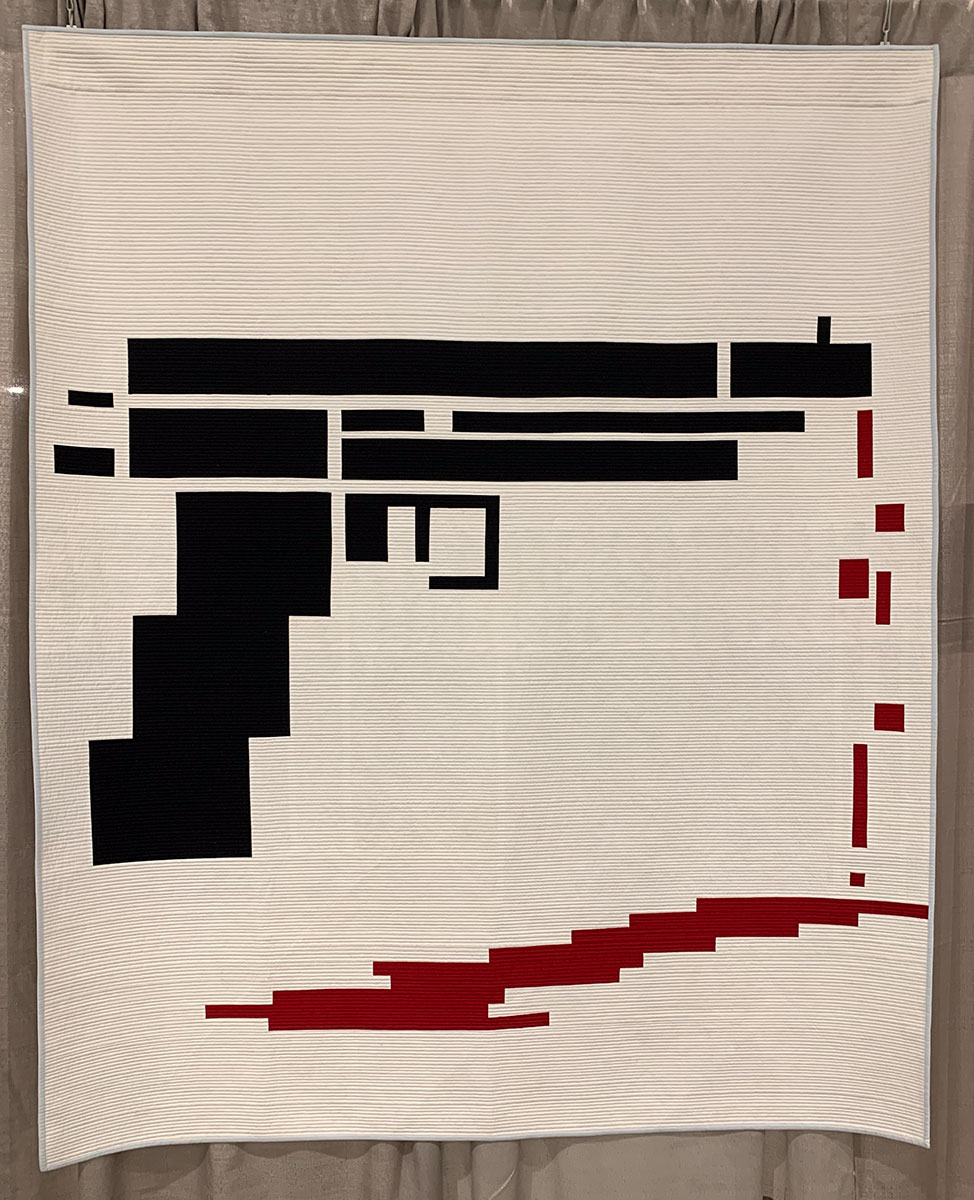
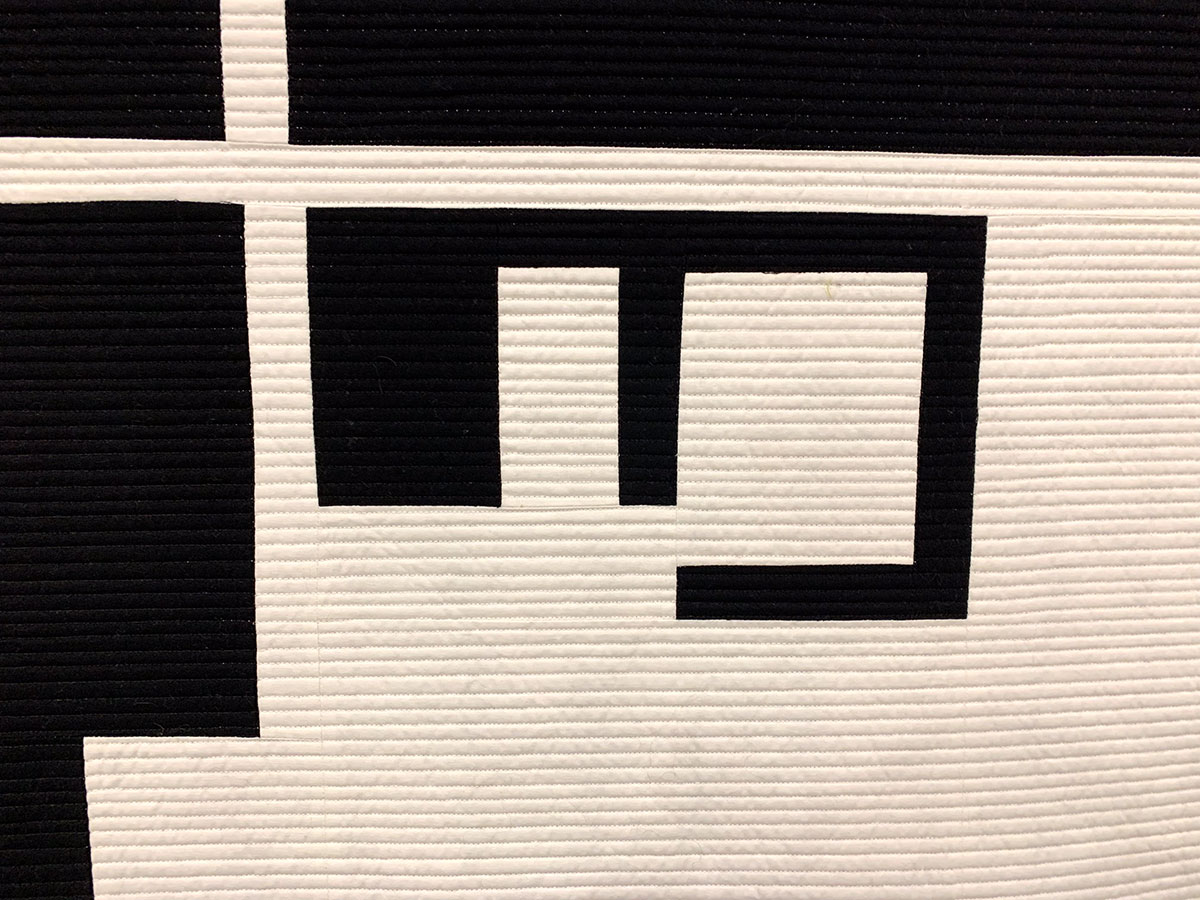 bang you’re dead
bang you’re dead
2013
64″ x 78″
Quilted by Anne Christopher
Artist Statement: ‘bang you’re dead’ was inspired by my husband’s work with the Chicago Public Schools. Each day when he went into work he received the Overnight Violence Report, an email which listed the students who had been shot, stabbed, killed, hurt that day in the city. Every day there was a name on the list. What he knew created a sense of urgency for him as an educator and he wore the weight of a half of million kids on his shoulders. I made the quilt as an “in your face” way to increase awareness of the violence that occurs each day in our country. It is easy to ignore when it’s not in your city, your neighborhood, or your family. Violence is everyone’s problem. The scope of the problem is broad and there are many causes. I am not naive enough to say that eliminating or controlling guns is the only way to to address the problem, but it is part of the solution. What I do know is that the solutions are many and we are in the position to contribute to the solution whether it be in our personal lives or in the jobs we do each day. It is time to act. Almost eleven years later, after the deaths of many more adults and children, it is still time to act.
Techniques: improvisational piecing, longarm and walking foot quilting
chomp quilt
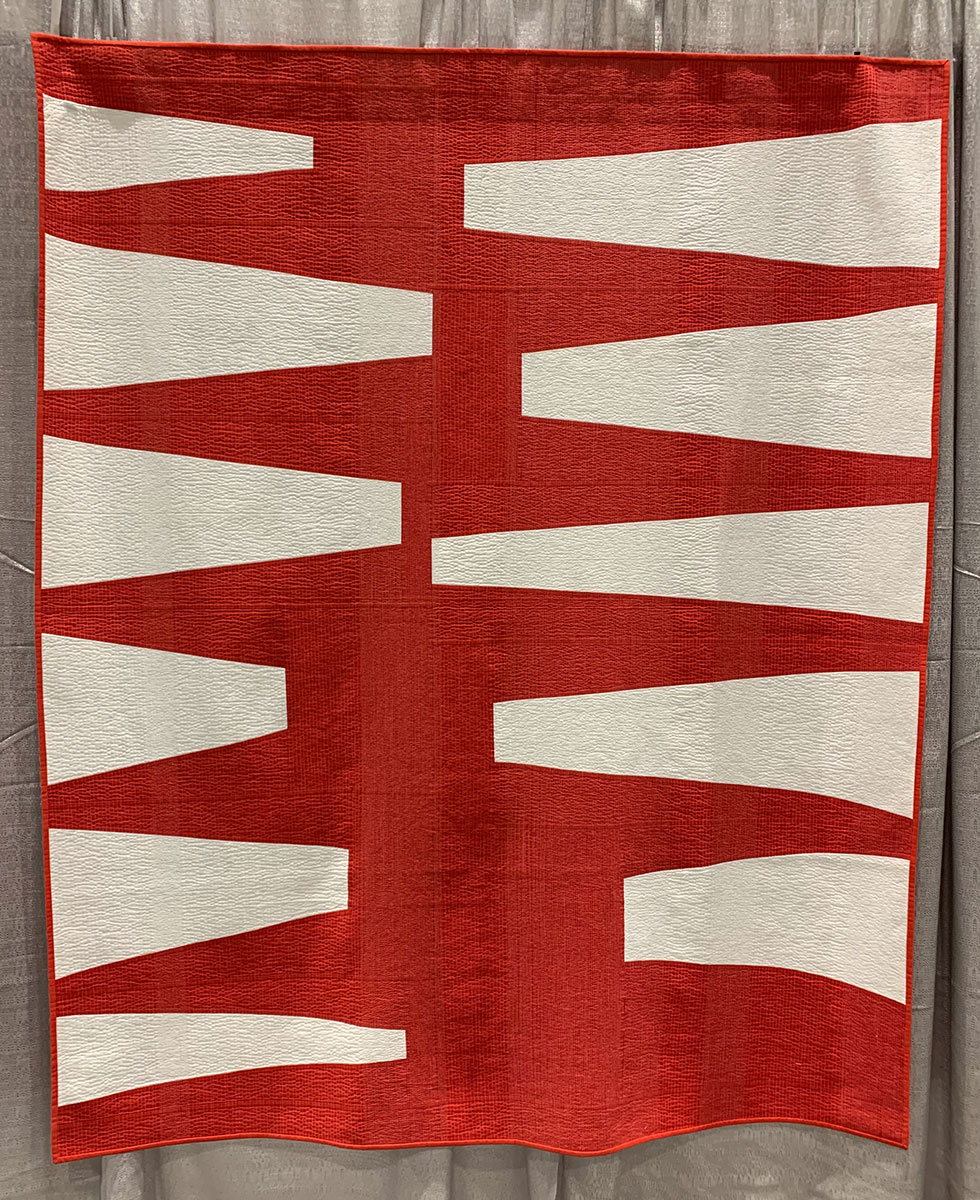
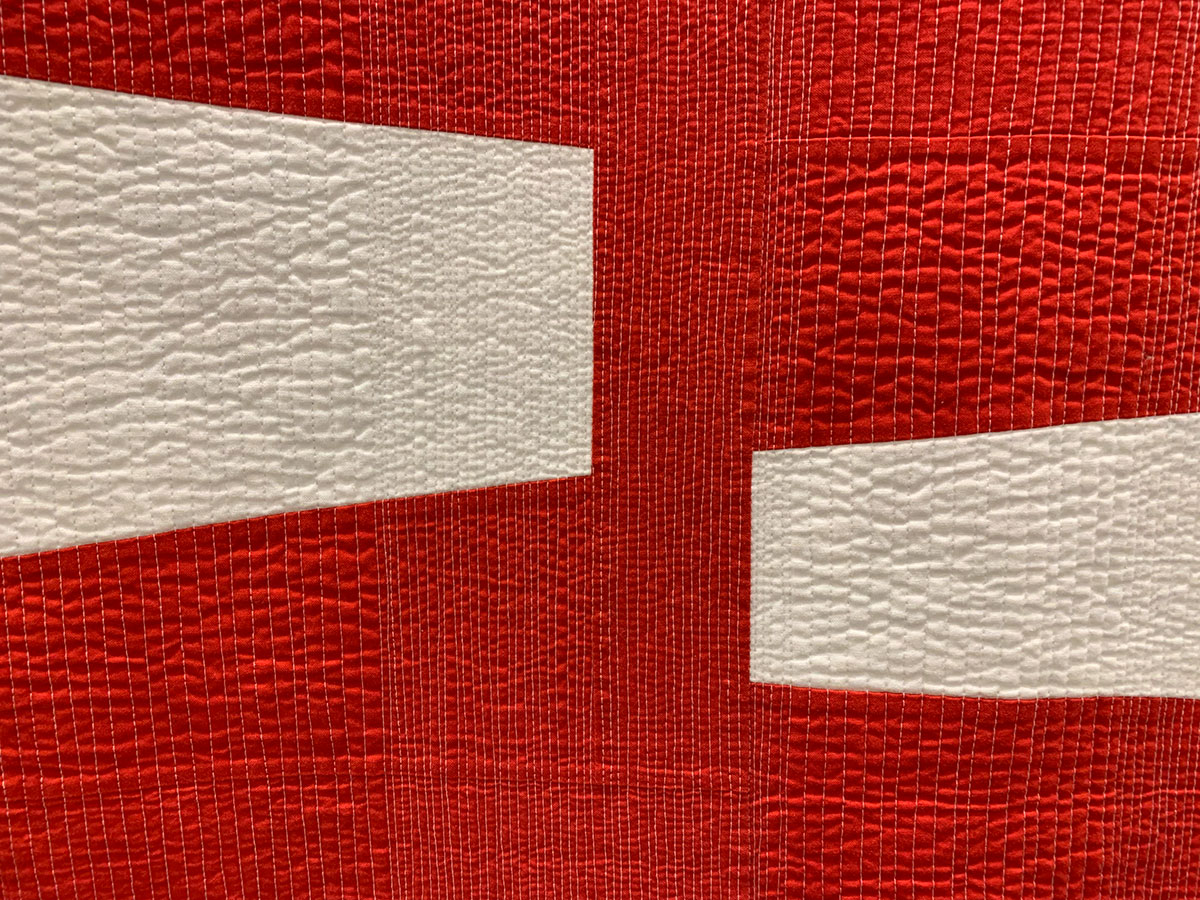 chomp
chomp
2017
60″ x 70″
Artist Statement: In 2016 I read the book Notan: The Dark-Light Principle of Design by Dorr Bothwell and as I worked through the exercises in the book, I wondered how the concepts in the book might be integrated into my practice. I was especially taken by the concept of the even exchange of positive and negative space and achieving Notan. I made several quilts in my Notan study series and this quilt was my most successful attempt at achieving this concept. I sought to create Notan through realization of negative and positive shapes in an equal exchange. The figure and ground of this piece become equally important to the whole. The background is no longer support for the subject but becomes as dramatic and integral as the subject itself. Stand back, look at the quilt and squint a bit. Notice how sometimes the dark (orange) dominates and sometimes the light (white) comes forward. The endless exchange between form and space excites me. The quilt is named ‘chomp’ because the design is inspired by the teeth of those giant machines that chew up the asphalt road. Inspiration is everywhere! I quilted the piece with matchstick quilting using 1/4″ and 1/8″ intervals which create shadow and depth in the background texture.
Techniques: improvisational piecing, matchstick walking foot quilting
shape study quilt
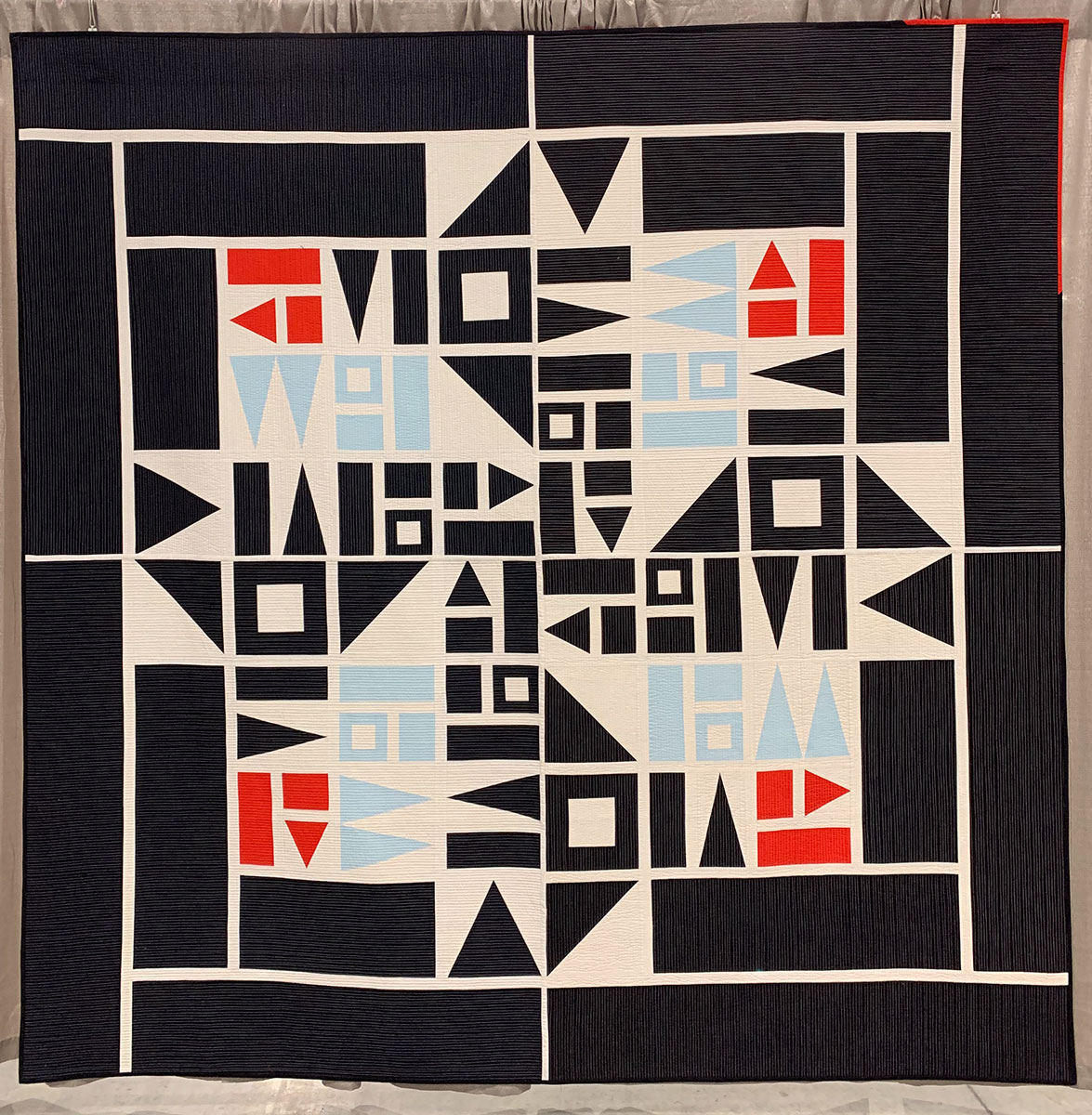
 shape study
shape study
2019
88″ x 88″
Artist Statement: Quiltfolk magazine asked me to work in collaboration with another quilter to translate a traditional quilt into a modern version for their pattern project. Tradition is my touchstone, so I accepted the challenge and chose to use Mary Toscano’s log cabin quilt as my inspiration, ‘shape study’ is a log cabin quilt pieced with the traditional spiral method. The quilt consists of four log cabin blocks. I supersized one of the prints in Mary’s work so it acts as a large-scale print in the quilt. Because of the color placement the black shapes create a center medallion shape that disguises the log cabin structure. The quilt is quilted with simple linear quilting and constructed quilt-as-you-go in four sections.
Techniques: traditional piecing, walking foot quilting, quilt-as-you-go
building bridges quilt

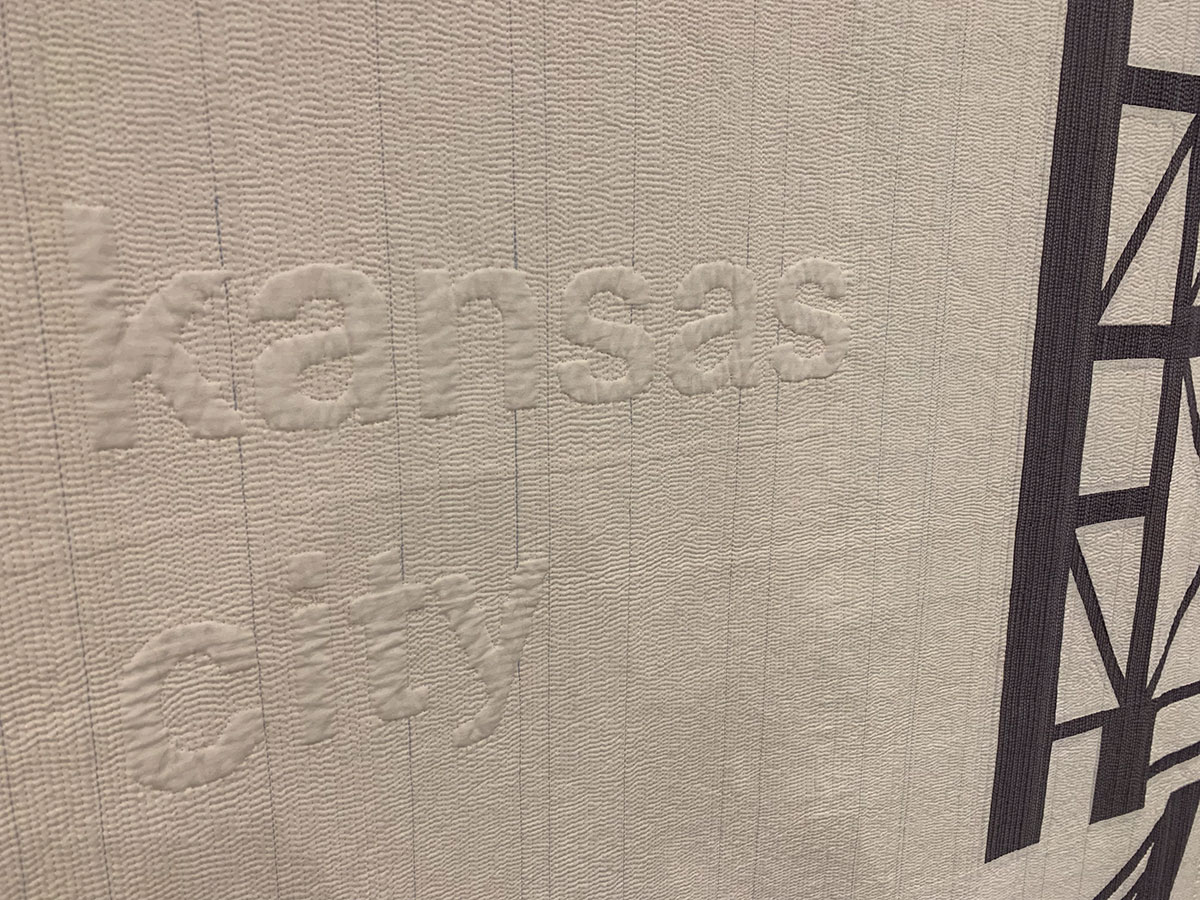
building bridges
2012
70″ x 85″
Quilted by Sheryl Schleicher
Artist Statement: In 2012 I moved to Chicago from Kansas City. From 150 acres to 900 square feet. After walking around the city with my dog, Bruno, for a few months I started to realize that Chicago was the city of bridges as I crossed over and walked under the bridges in the city. A bridge became a symbol of the tradition from one city to another, from one very different life to another. Over the years the quilt has become a metaphor for building bridges, between people, between lives, within communities. My friend from Kansas City, Sheryl Schleicher quilted this piece with matchstick quilting and leaving unquilted areas to allow the words span, passage and connect and Kansas City and Chicago to appear on the quilt. Look closely and notice the randomly space dlight blue threads across the quilt. Sheryl’s special touch.
Techniques: improvisational piecing, matchstick longarm quilting
shattered quilt


shattered
2012
62″ x 77″
Quilted by Angela Walters
Artist Statement: We were living in the country on 150 acres outside of Lawrence, Kansas and one day when my husband and I were at work and the kids at school, a couple of young men decided to attempt to break in into our house. It was the perfect location for a crime, an isolated house on acreage, with lots of trees to shield the perpetrators and no one could see you from the road. They broke the large picture window at the back of the house in their attempt, but they were surprised and scared off by my 80-year-old mother driving up the back hill on her baby blue golf cart waving a broom. Even though the attempt failed, we were left with a big, busted window and large insurance deductible that was tough to handle at the time. I was angry. The broken window inspird the design, and the anger inspired the colors. My son Ben loved this piece from the day I put the first block on the design wall. He owns it now and generously lends it to me for exhibits. I did promise to return it promptly this time.
Techniques: improvisational piecing, long arm quilting
From the collection of Ben and Courtney Gering
acorn star quilt
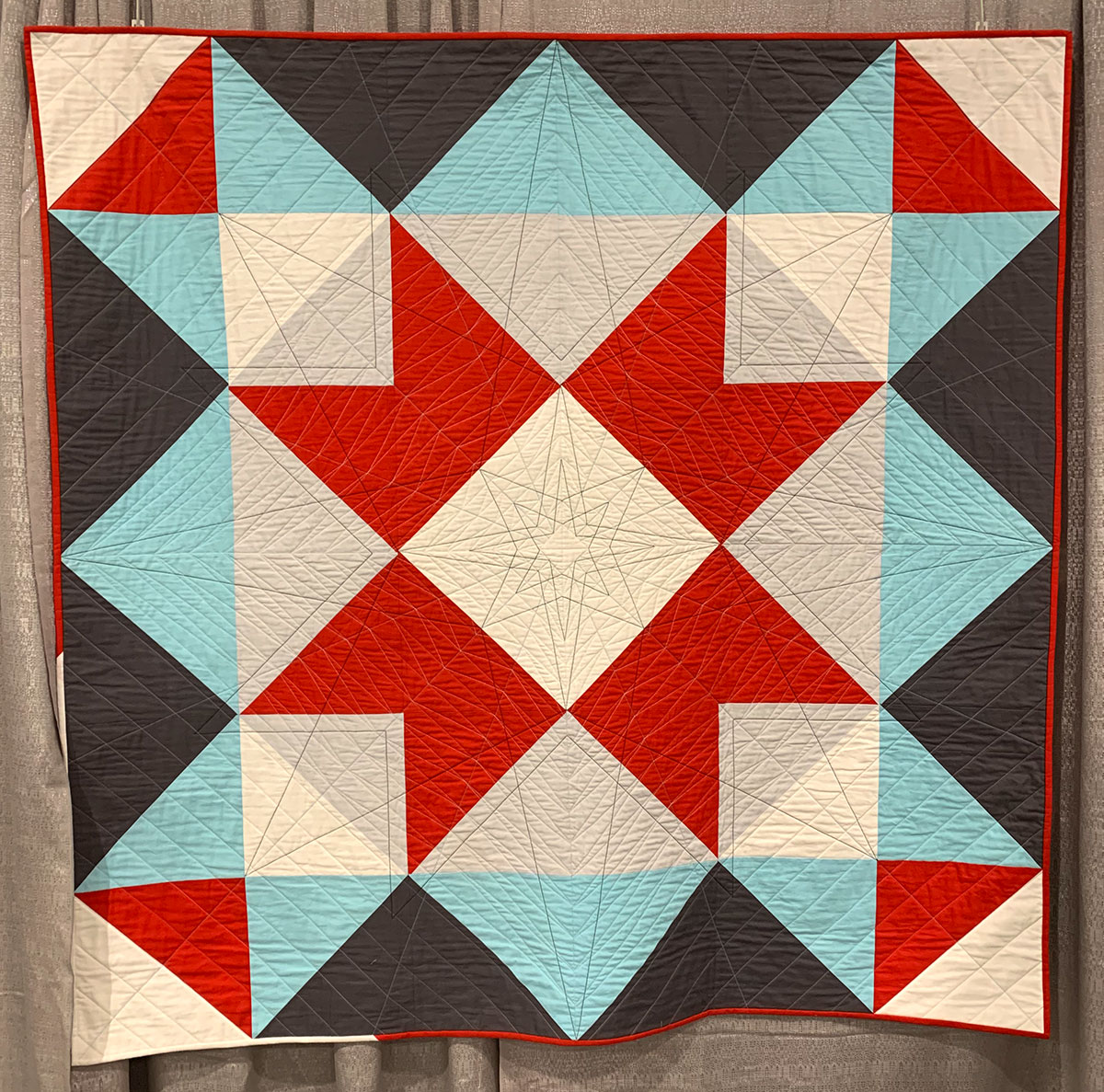
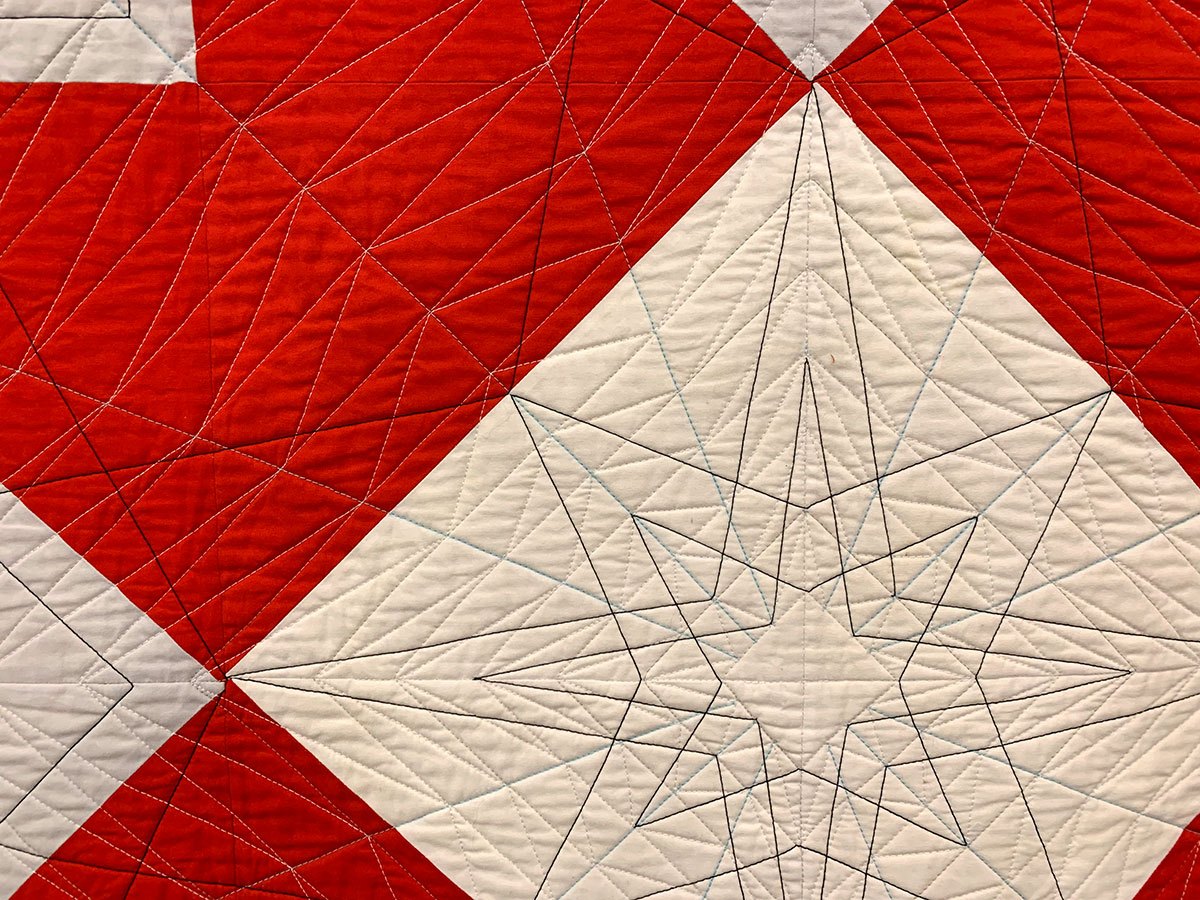
acorn star
2016
Artist Statement: “acorn star” is a traditional star block blown up to full quilt size scale. The design is simple and was made to test quilting designs for WALK 2.0. When I’m working on developing new walking foot quilting designs, first they’re drawn on the computer, then I quilt them on 20″ x 20″ samples, and the I try and quilt each design on full size quilts. If I can do it, then you can do it. “acorn star” is quilting with several walking foot designs and it is accented with layered quilting in 12 weight thread which I added after the quilt had been in the book. I always though the quilt needed something else, and a few lines of black thread transformed the quilt into a quilt that I now love.
Techniques: Traditional piecing, walking foot quilting, layered quilting
missing pieces quilt


missing pieces
2023
70″ x 72″
Artist Statement: Good health is the foundation of a good life, yet despite taking care of ourselves, we experience health scares and devastating diseases. I have been fortunate to live a healthy life until one day I forgot who and where I was, and my brain stopped recording. For my loved ones it was terrifying, for me, I was happily oblivious going about my day, driving, gardening, helping my oldest son until he recognized during a conversation over lunch that I wasn’t tracking and didn’t remember a thing about the recent past. After loads of tests the doctors diagnosed Transient Global Amnesia. (TGA) is a sudden, temporary interruption of short-term memory. Although patients may be disoriented, not know where they are or be confused over time, they are otherwise alert, attentive and have normal thinking abilities. I recognized my husband and kids but had no clue what I had been doing over the last few days and I asked my husband over and over to “walk me through the day.” I don’t remember having any scans or a drive to the hospital, but I did get testy every time the nurse asked me my name, what day it was and my birthday. My brain began tracking again over time and I went home my normal self, but those days are still lost to me. This piece reflects the loss of those days and my efforts to release myself from my experience with (TGA). For a long time, I was scared to leave home or travel and every day I would wake up and ask myself what I had for dinner the night before. If I could remember I knew I was good. This quilt is pieced with Jenny Hayes oval templates and is quilted with simple linear walking foot quilting.
Techniques: traditional curved piecing, walking foot quilting
jay’s star quilt
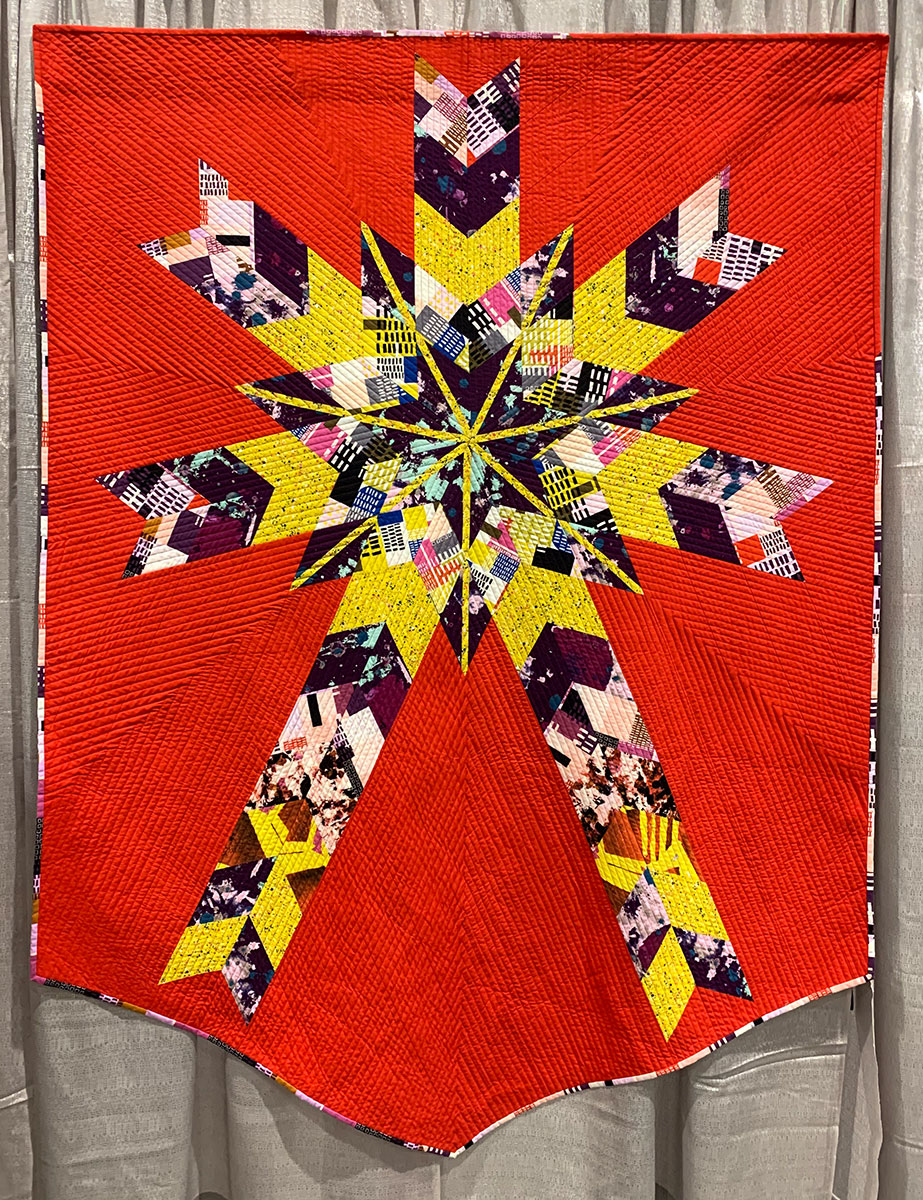
 jay’s star
jay’s star
2019
56″ x 76″
Artist Statement: Jay McCarroll won the inaugural season of Project Runway and later designed a fabric line called Center City. I’m not much for prints, but Jay’s fabric was so different than the other fabric lines out at the time, I fell in love with it. When I decided to make this seven-pointed star quilt in 2019 fr the challenge of it, I chose Jay’s quirky, bold fabric for this project. Seven-pointed stars are rare in the quiltin world, and it was a challenge to draft and to piece and it was what I needed at the time to ignite my creativity. I also felt that the design didn’t feel right as a square or a rectangle, so I gave it a unique shape. The lines that meet in the center of the star were an afterthought… Gwen Marston sitting on my shoulder whispering, “What would happen if?”
Techniques: traditional piecing, walking foot quilting
Want to see more modern quilts?
Check out these links for quilts from previous QuiltsCon exhibits:
Check out the 2017 Modern Quilt Showcase.
Check out the 2018 Modern Quilt Showcase.
Check out the 2018 Best of QuiltCon traveling exhibit.
Check out 20 modern quilts from QuiltCon 2019.
Check out 9 modern charity quilts from QuiltCon 2019.
Check out the 2019 Modern Quilt Showcase.
Check out 20 modern quilts from QuiltCon 2020.
Check out 15 modern quilts from QuiltCon 2023.
Check out 10 modern quilts from QuiltCon 2024.
